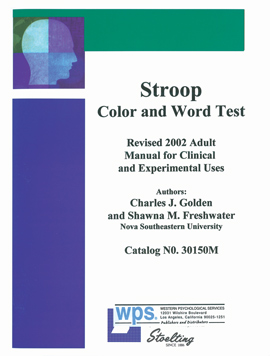 Here is a standardized version of the Stroop Color and Word Test, which maximizes the benefits of this popular measure of cognitive processing. The Stroop is based on the observation that individuals can read words much faster than they can identify and name colors. The cognitive dimension tapped by the Stroop is associated with cognitive flexibility, resistance to interference from outside stimuli, creativity, and psychopathology–all of which influence the individual’s ability to cope with cognitive stress and process complex input. Whether the test is used as a screener or as part of a general battery, its quick and easy administration, validity, and reliability make it an especially attractive instrument. The test features a three-page test booklet. On the first page, the words “RED,” “GREEN,” and “BLUE,” are printed in black ink and repeated randomly in columns. On the second page, the item “XXXX” appears repeatedly in columns, printed in red, green, or blue ink. On the third page (referred to as the interference page), the words “RED, “GREEN,” and “BLUE” are printed in red, green, or blue ink–but in no case do the words and the colors in which they are printed match. For example, the word “BLUE” appears in either red or green ink. The subject’s task is to look at each page and move down the columns, reading words or naming the ink colors as quickly as possible, within a given time limit. The test yields three scores, based on the number of items completed on each of the three stimulus sheets. In addition, you can calculate an interference score, which is useful in determining the individual’s cognitive flexibility, creativity, and reaction to cognitive stress. Administration time is just 5 minutes. While the adult version of the test is appropriate for individuals 15 years of age and up, a new children’s version can be used with 5- to 14-year-olds. Specifically designed for, normed on, and interpreted for children, this version generates T-scores, by age, based on means and standard deviation. (Adult T-scores are based on multiple regression equations, using age and education.) Stroop results can be used in the diagnosis of brain dysfunction and in the evaluation of stress, personality, cognition, ADHD, and psychopathology. Because it is brief, requires very little education, and is not culturally biased, this unique test is an ideal way to screen for neuropsychological deficits. Component KIT: Includes 1 Manual; 25 Test Booklets | ||||||



